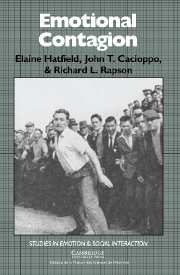Book contents
- Frontmatter
- Contents
- Acknowledgments
- Introduction and overview
- 1 Mechanisms of emotional contagion: I. Emotional mimicry/synchrony
- 2 Mechanisms of emotional contagion: II. Emotional experience and facial, vocal, and postural feedback
- 3 Evidence that emotional contagion exists
- 4 The ability to infect others with emotion
- 5 Susceptibility to emotional contagion
- 6 Current implications and suggestions for future research
- References
- Index
5 - Susceptibility to emotional contagion
Published online by Cambridge University Press: 05 June 2012
- Frontmatter
- Contents
- Acknowledgments
- Introduction and overview
- 1 Mechanisms of emotional contagion: I. Emotional mimicry/synchrony
- 2 Mechanisms of emotional contagion: II. Emotional experience and facial, vocal, and postural feedback
- 3 Evidence that emotional contagion exists
- 4 The ability to infect others with emotion
- 5 Susceptibility to emotional contagion
- 6 Current implications and suggestions for future research
- References
- Index
Summary
Introduction
Blanche … could detect sorrow, could detect it a mile off. … The gift of compassion is born in one or does not exist at all; the artificial commodity, assumed or advertised, misses too many clues.
–Anita BrooknerDoes everyone have the capacity to share the joy, love, sadness, anger, and fear of others? Or do individuals differ markedly in their ability to get swept up in others' emotions? We assume that personality, self-construals, genetic heritage, and early experiences predispose some people to be unusually susceptible to emotional contagion and others to be unusually resistant to it.
Theoretical background
A century ago, Gustave Le Bon (1896) wrote about the mysterious forces that operated when people congregated to form crowds. Feelings of membership within a crowd, Le Bon argued, contributed to an enlargement of the ego (a sense of power), the release of impulses, a sense of contagion, and heightened suggestibility. These psychological characteristics, Le Bon argued, derived from the absorption of an individual's identity into that of the crowd. The effective crowd leader, Le Bon reasoned, relied on the affirmation of simple, imagelike ideas that point directly to action, and on the repetition of these imagelike ideas: The affirmation evokes the image, the image evokes a sentiment, and the sentiment leads to action. Individuals in the crowd mimic the actions of the leader, and this mimicry, once initiated, infects all in attendance.
- Type
- Chapter
- Information
- Emotional Contagion , pp. 147 - 182Publisher: Cambridge University PressPrint publication year: 1993
- 3
- Cited by

